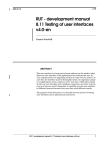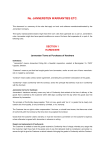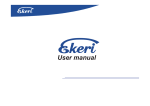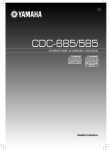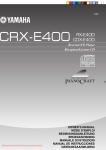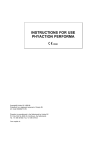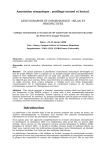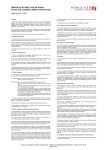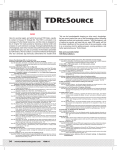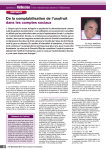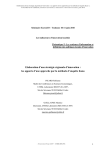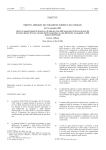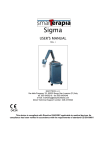Download 5.1 Contract contents v4.5 en
Transcript
LiTH 2005-01-14 RUT - development manual 5.1 Contract contents v 4.5 Martin Virdung Abstract This report gives a brief overview of the contents in a contract and how they are created.Different types of contracts and who may sign them is also treated in the report. The course of action when a contract disagreement occurs is also dealt with. Finally an example agreement in a punctuated form is supplied to illustrate that there are quite a lot to consider when an agreement is reached. RUT - development manual 5.1 Contract contents v 4.5 1 Field of application 1 Field of application A contract is by definition a written agreement. In this report the term agreement is used as this is the conventional term used amongst legal experts. Verbal agreements are valid according to the law, but as those are unusual and sometimes hard to substantiate they are only covered briefly. This report gives the reader an overview of the process involved in creating different agreements, their content and which persons that may sign them. ***The report also contains a chapter that treats the measurability of the process. As it is hard to measure how good an agreement is you can however with test discover treacherous weaknesses in the agreement. In business relations agreements refers to purchases, rentals, cooperation and other commercial or economic interests. 2 Prerequisites 2.1 Who may sign an agreement? For an agreement to be valid it has to be signed by an authorized person. Sometimes this may be indistinct. In government authorities they usually have internal instructions that regulates who is allowed to sign an agreement. In companies it’s formally only the president and a few more persons that are allowed to sign agreements in the name of the company. The formal right to sign agreements in the name of the company is often complemented with powers of position to other persons in the company. A power of position means that a person can sign agreements that comply to the position in the company e.g. a cashier can sign an agreement regarding selling food but not hire out the premises without a power of attorney. Because of this there is a risk that the agreement is not valid as the person that has signed the agreement does not have the right to do so. Therefore it may be good to control that the person that is signing the agreement has a power of attorney from an authorized person. If this is not the case the possibility to get right in a dispute still exists according to the law concerning agreements signed in good faith. However it can be costly and strenuous to prove good faith in court. 2.2 Law of purchase The law of purchase is the basis for agreements between entrepreneurs. The law regulates purchases of personal property and “orders of a product that will be produced” (KöpL 2§). Personal property refers to every form of movable objects and intellectual properties and characteristics. The law of purchase is optional, meaning that the existing agreement is the prevailing one. If no agreement exists the law of purchase is valid. In addition the law of agreement is also valid. For more information see (backstig, 1999), where the law of purchase, the law of agreement and Letter of Intent are discussed. 2 RUT - development manual 5.1 Contract contents v 4.5 Realization 2.3 Further education If you want to get further juridical education, courses like “Juridik för M” and “Datajuridisk översiktskurs” is recommended. They are quite short, 2.5 and 2 points, but contain the basic and essential parts of agreement law. Or you can read (Rombe, 1996) which gives good basic knowledge in the subject. 3 Realization 3.1 Overview How is an agreement established? Here follows how an agreement can be signed: • • • • • • Two signed copies of the agreement (one each) Offer + acceptance letter (order acceptance) Offer + signed copy of offer by the buyer Protocol + customer signature Verbal agreement + endorsement letter (silent accept) Verbal agreement + verbal agreement As the description reveals, agreements can be one-sided or mutual. One-sided agreement One part sends a document to the other part which completes the agreement by accepting it. Offers and accepts may be exchanged in writing or electronically. Agreements can also be conceived by action e.g. a user downloads a computer program from a web site where certain conditions are stated. Mutual agreement Mutual agreements are the normal procedure at larger affairs. The mutual part means that you create two copies which are then exchanged after both sides have signed it. Verbal agreement Verbal agreements are not that common at larger affairs but is nonetheless juridical correct. An offer that is given verbally to someone must be accepted immediately to be valid, unless you agree upon a time-limit for the acceptance. The problem with verbal agreements is the difficulty to prove that an agreement actually exists, especially if it contains many details. Qualified accept If the buyer, as a response to an offer, sends an order that differs from the offer, you don’t have an agreement but a “qualified accept”. The response from the buyer is then regarded as a new offer that must be answered by the seller to reach an agreement. To reach an RUT - development manual 5.1 Contract contents v 4.5 3 Realization agreement the seller must accept the differences in writing. If he comes with objections there is no valid agreement. It is important that the buyer makes his order during the time the offer is valid. If the seller gets an order after the valid time of the offer he does not have to stand by the offer. A prerequisite for this is that the seller within reasonable time informs the buyer that he does not accept, otherwise the agreement can be valid if the buyer is in good faith. Dispute Regardless of how well-reasoned an agreement is you can always come to a dispute. It is impossible to predict every possible situation and regulate those in the agreement. It’s far easier to describe in the agreement a course of action at a potential dispute. This is in business matters often solved in a dispute clause (see chapter 8“Solutions to common problems”, page 11). 3.2 Detailed description Some of the more important points in agreements are discussed in detail below. The exact text is however not discussed. For that we refer to a lawyer who is more knowledgeable in computer juridical. Important points One question that often rises is whether the supplier sells what is offered or if the buyer buys what’s specified in the specification of requirements. If the agreement is vague the parties can disagree on what’s in effect. Therefore it is important to have control over the points of agreement and which documents that has a character of agreement. The agreement shall clearly state what applies to different matters. Below are some points that should be included in the agreement: • • • 4 Definitions To avoid uncertainties regarding the agreement everything must be well defined so no ambiguous statements are included e.g. Are both hardware and software meant when the product is mentioned? If there is no clear definition on ambiguous words in the agreement misunderstandings may easily appear. Clarification of functionality The functionality that the buyer has described in the offer often needs to be clarified. If the customer does not understand the system that they are about to buy you might have to lend them a helping hand. By describing the systems future functionality thoroughly in the agreement you avoid future disputes and disagreements. Specification of requirements The product shall fulfill the requirements in the specifications that the seller and buyer have agreed upon. Often if the specification of requirements is changed the whole contract must be renegotiated. This can cause the buyer to claim for damage or to revoke the contract. If the agreement does not mention claims for damage or contract revoking the law of purchase is valid. One important aspect is that the requirements must be controllable at the point of delivery. It may be suitable to couple the delivery protocol and the specification of requirements so that the control of the different requirements is stated. It is also important to specify the requirements on the buyer e.g. the preparations needed by the buyer, environment or products that will be integrated RUT - development manual 5.1 Contract contents v 4.5 Realization • • • • • • with the delivered system. If the buyer does not fulfill these requirements the seller is not responsible for eventual faults or delays. Delays The product may be delayed if the seller encounters large problems. This can become very expensive for the customer if he is forced to change contractor or if he needs to install backup systems to run his business. The customer can then, according to the law of purchase, cancel the agreement and claim compensation for damages. To avoid such situations the course of action should be specified in the agreement. Freight The freight for delivery is not always regulated by the parties in the agreement. It is important to have an agreement regarding the delivery of the goods as you need to know when the risk is transferred from the seller to the buyer. If the buyer is responsible for the risk he must pay for the goods even if it is destroyed, lost, deteriorated, or is diminished by an event not depending on the seller (KöpL 12§). The risk is transferred to the buyer when the goods is delivered. One way to solve the problem is to let a freight company answer to the risks. There exist some more or less standard delivery contracts. The delivery contracts are described in (Backstig, 1999). Functional guarantee If you give a guarantee the requirements to get a claim shall be thoroughly described. Remember that if nothing else has been agreed upon you, as a seller, have two years liability for faults toward the buyer, stated in the law of purchase. But it falls on the customer to prove that the product was faulty, which may not be so easy. In practice it is impossible to know if the system is free from faults even after extensive testing, you usually have a clause in the agreement stating that the seller is not responsible for small faults, but guarantees to correct them for a fee. Limitation of liability As a seller you should be careful to put down assignments of liability e.g. indirect losses that can arise due to the delivered product. If this is not done, the law of purchase is valid. IT-agreements usually contain some form of limitation of liability, which means that the sellers’ liability for the product is not as vast as the law of purchase regulates. The limitations often regard liability for some types of damages and to a certain maximum amount of money. Most commercial agreements also contains a force majeure clausal, which states that the seller is not reliable for events out of his control, not foreseeable and not manageable with reasonable effort. Conditions of acceptance – acceptance test An acceptance test gives the buyer the possibility to check that the agreed products and services comply with his order and expectations. In the agreement one should specify how the acceptance test will be performed e.g. the buyer shall contribute with personnel and relevant data for the test. A clausal stating that if the buyer does not within a specified time frame replies that he does not accept the system it should be regarded accepted. If the acceptance test fails it should be considered as a delay of delivery, which lead to compensation claims from the buyer. If the buyer accepts the test he cannot later on point on faults on the system and claim compensation. As a seller of a system it can be smart to finish the acceptance test well ahead of the installation to see what needs to be developed to get the system accepted. Time of guarantee The start and end of a guarantee must be predefined; does it start when the program is installed or when it works for 90% or 100%? Operation hours should also be speci- RUT - development manual 5.1 Contract contents v 4.5 5 Realization • • • • • • • 6 fied, if the guarantee is valid for 90 days is only work hours (8.00-17) implied or the whole day and night? If a complaint is made regarding original faults of the product within two years of purchase, the law of purchase states that the seller is liable. Regarding software, at least for PC’s, it is uncommon with guarantees that are as long as the law of purchase, as software tends to be outdated within two years. For PC software guarantee-times often is 3-12 months. Prices Under the pricing heading you often make agreements upon the economic conditions regarding the purchase and conditions for upgrading in the future. If the product is not finished there exist several pricing models that can be used. Some of the most frequently used ones are described below (see “Pricing models and variants thereof regarding service agreements”, p 6) Payment The customers most important task is to give the seller payment. It is most common that the buyer pay later. In long term agreements the customer may be obliged to pay periodically. The buyer is however not bound to pay until the seller has given account of what have been done (Hellner 2002). Maintenance The agreement should regulate who is authorized of performing system maintenance; it should also specify the service level that the seller has both regarding parts and the whole system. For acute faults a time frame for the repairs should be specified. The customer should begin with an assessment of the risks and the consequences of possible operation disturbances, thereafter a balanced consideration of the risks and the costs of maintenance must be done. Maintenance of hardware and software is considered a service, as such the law of purchase is not applicable and there exist no law for services besides one solely for consumers. Therefore freedom of agreement exists for maintenance. Copyright - usufruct Here you agree upon the copyright of the software that is included in the system. Copyright means that the author is exclusively entitled the work by producing copies thereof and to make it publicly available. The number of licenses and so on should also be agreed upon. Conveyance of agreement This point of agreement should state in what way the customer can convey the agreement to another part. This can be the case if the company that has bought the system is acquired by another company. Fines To put pressure on the seller the agreement can contain fines. This means that if delays occur the buyer can demand a fine. A fine is of a predefined amount that is to be omitted without any burden of proof for the buyer. Fines are normally specified per delayed week or delivery day, depending on the importance of a kept delivery time. Levels between 0.1% and 1% of the total amount of the agreement per week is normal, dependent on the extent of the system, adaptations and the customers need for a kept time table. Insurances Insurance-wise the installation of the system is an uncertain area. Often the customer does not take over the responsibility, e.g. the risk, for the hardware before the accept- RUT - development manual 5.1 Contract contents v 4.5 Realization • ance test is approved upon, but at the same time the sellers insurance does not cover incidents that do not occur outside the company. Therefore it is common to add into the agreement that the customer is responsible for the goods as soon as it is received. Infringement Here the assignment of responsibility between the parties is defined, in the case that the delivered products constitute third parties intellectual properties, i.e. patents or copyright. There have been cases where a program supplier has given licenses for software of which he had no right of disposal. Which responsibility does the supplier have towards the customer? Other documents included in the agreement • • The agreement should include other documents that are included in the sale. Some of those documents are mentioned below: User manual. Technical documentation. The seller still has the copyright for the documents supplied in the sale, this means that the customer cannot make copies of the documents to be used in the company. If this is done the seller is entitled to compensation. Models and variants of pricing for service agreements To write an agreement of services differs quite a bit from a goods agreement. One point being that what is bought can not always be specified in advance. Therefore it is hard to know the final cost. There exists different constructions to handle the problems that can occur during these situations. The most important ones are: agreement on fixed price, budget price, limited budget price, incentive budget price, incentive and limited budget price, current account and incentive current account. The constructions above depend on the following basic constructions: • • • • Fixed price agreement This means that the price is agreed upon in advance. If the supplier can achieve the service cheaper than calculated he earns the winnings. If it gets more expensive he stands for the extra costs. Fixed priced agreements can be good if the specifications of the system are detailed and one has a clear picture of how the system is to be built. As a seller you always need to do a risk mark-up when calculating the price. A vague specification of the system gives a large mark-up. Development agreement If the seller wants to try new products or have the opportunity to let other customers study an installation, a development agreement can be signed. This is in practically done by letting the customer obtain a rebate, while the seller gets the opportunity to develop a product in cooperation with the customer. If it is a completely new product the seller often has the right to a certain number of visits to show the system to presumptive customers. This is often a valued form for both parties, as the buyer gets a lower price and the seller has the opportunity to show a running system with users in the targeted environment. Current account Current account is the opposite to a fixed price agreement. In this case the customer pays all the costs the seller has had in the commission. Budget price RUT - development manual 5.1 Contract contents v 4.5 7 Results • • Budget price means that the seller has given cost estimation but does not guarantee it. This is essentially the same thing as current account, but the seller has a moral obligation to hold the costs within the given budget. He also risks a bad reputation if he can not hold his budget. Limited budget price This is the same as budget price but the price limit may not be overridden. If any extra costs appear the supplier is the one who stands for the extra cost, but if it gets cheaper it is the buyer who gets the profit. This is the worst alternative for the seller. Incentive Incentive in combination with any of the alternatives above means that the seller and buyer share all profits or expenses over the agreed sum. The way you do it is by defining a reference price which is a guesstimate of the end price. Then the parties agree upon how the deviations should be distributed. Time losses or time winnings are often regulated with an incentive clausal. 4 Results 4.1 Products An agreement that regulates a business deal between the parties. 4.2 Product templates There exist several standard agreements that can be a good basis for an agreement, the foremost example of this is agreement 90 (avtal 90). Larger corporations often have their own standard agreements that are written by the company lawyers. 5 Templates and forms 5.1 Standard agreement There exist a number of standard agreements in the computer-area that are relatively neutral considering interests. If the organization does not have any agreements, these can be a good starting point when writing an agreement. Some standard agreements Agreement 90 (avail 90) is a commonly used agreement when selling goods. Agreement 90 has been developed in cooperation between LKD (Leveransföreningen Kontor och Data), DF (Dataföreningen i sverige) and Silf (sveriges inköps- och logistikförbund). Agreement 90 is produced by representatives of both sellers and buyers, therefore some of the initial “negotiations” are settled. The agreement is commented, which makes it relatively easy to use. ABDAKA is another agreement that often is used when selling services, it is written after the same principles as agreement 90. 8 RUT - development manual 5.1 Contract contents v 4.5 Verification of results Adaptation of a standard agreement The requirements on software can differ quite a lot, it is therefore hard to find a fitting standard agreement. You can even save much time by writing your own agreement, especially if it is about small software. You already have some protection by the laws of purchase and agreement. If the seller or buyer wants to change anything that is praxis, you just adopt the agreement. These adaptations then take precedence. To adjust the standard agreements to the specific deal you add the points you want and then add one more point that states something like: “point 1 to x is the valid ones if any other statutes in this agreement”. It is recommended that you get a standard agreement and rewrite it so it suits both parties and then let a lawyer examine the agreement. 5.2 Checklist for system delivery The checklist in appendix A is a summary of the types of regulations that can be included in different types of system deliveries. The list also includes maintenance and license. The list is intended to be a checklist for the most essential statutes in the agreement. An asterisk (“*”) indicates that the clausal should be included in the agreement 6 Verification of results At any agreements where there are doubt regarding the contents you should let a lawyer inspect the agreement before signing. All parties involved in the agreement should always consult a legal expert to assess the agreement, it is nice to use some form of checklists when doing this. 7 Examples with explanations It is hard to find real examples of agreements as they very often are secret. This, translated, agreement is retrieved from (Ahlstedt, 1990). The following example regards a sale of software for collection of debts and adherent services. It is, however, not a standard agreement, it is adapted to the purposes of this particular company. The motivation to include this example is that it illustrates that it is not trivial to write an agreement. The agreement is translated and can be found in Swedish in (Ahlstedt, 1990). Example - Avail Software 1995 Range of agreement Through this agreement the customer obtain, a non-transferable, usufruct (so called single licence) for the software: I – Inkasso.The customer has the right to use the software freely, only on one computer within the company, if no special permission is granted. Delivery and payment RUT - development manual 5.1 Contract contents v 4.5 9 Examples with explanations The delivery shall take place on the specified point of time.During transport the supplier stands for the risk.Delivery may occur through COD or any, specified by the supplier, equivalent method.The customer compensates the supplier for the cost of delivery. Duty of informing When delivery delays occur the customer shall be notified, the cause of the delay and a new delivery date shall be included.The supplier shall, when upgrading the software, state all changes made since the last published version.The customer take upon his self to notify the supplier of changes that are needed, omissions hereof are, however, not connected to any consequences. Delay The delivery is regarded delayed when the delivery date is exceeded with three months. The customer then has the right to cancel the contract. If the customer is insolvent the law of purchase is valid, except this agreements denoted exception. Warranty The customer is aware of the fact that software regularly contains small errors. The customer has had the opportunity to examine the goods and approve it. In cases of large errors the supplier assumes responsibility to adjust the software within 90 days, if notified within 6 months after delivery. The adjustment is not charged. If notified faults render the software unusable, the supplier has the right to, if the supplier does not want to correct the software, cancel the contract. When an agreement is made upon a cost free upgrade the customer has the right to cancel the contract if only if the software contains the notified faults. For this condition the limitations denoted in the first subsection, titled WARRANTY, are valid. Force Majeure Neither party shall be liable for any failure or delay in performance under this to the extent said failures or delays are proximately caused by causes beyond that party's reasonable control and occurring without its fault or negligence, including, without limitation, failure of suppliers, subcontractors, and carriers, or party to substantially meet its performance obligations under this Agreement. If such failure occurs the delivery may be cancelled. The suppliers liability for damages is limited to a maximum of 10% of the contract price. The suppliers liability is limited to cases stated in the agreement, no compensation for indirect losses or damages that the supplier possibly could not foresee, when the agreement is signed, are payed. Additional services For additional services the same rules apply according to the agreement, except the following exceptions. 10 RUT - development manual 5.1 Contract contents v 4.5 Solutions to common problems An agreement regarding additional service is agreed upon between the customer and the supplier. The order of such a service is sent to the supplier. The agreement is valid through a confirmation letter from the supplier. In this confirmation letter the way, addresses and phone numbers, in which the parities contact each other is stated. Service subscriptions exist in two forms, half service and full service.Halfservice includes all technical upgrades during the contracted time.Fullservice includes half service and a juridical service, where free counselling regarding area of collecting debts and moreover updates of the changes of law to the program. For service subscriptions a monthly fee of 200 skr, for half service, and 1200 skr for full service is issued. Payment is made quarterly in advance. The supplier has the right to change the charging rates, such changes will be notified to the customer and will occur no earlier than the next turn of the month.For both parties the period of notice is 3 months. Other conditions All complaints must be written to be valid. Payment shall always occur with delivery of the goods. In cases where a invoice is used the payment is due 10 days from the delivery of the bill.In this case services are also regarded as goods. Interest on overdue payment is 3% per month is applied if the customers’ payment is delayed.Changes or additions to this agreement must be written, or it is not valid. 8 Solutions to common problems Unreasonable time schedule It-agreements usually contain a time schedule for development, delivery, installation and other implementation. Problems following this schedule occur mostly when the system or software is installed at the customer or when software is developed for the customer. This usually originates from an underestimation of the labour effort required by the parties and by unpredictable difficulties that arises. Risk distribution for misjudgements and unpredictable difficulties must be stated in the agreement, this is done e.g. by regulations regarding delays and faults and by giving release from reliability. It lies in the interest of both parties to have ha certain flexibility in the agreement; they should aim at the completion of the agreement rather than giving generous rights of cancellation when delays occur. Usually this is made by having a mutual duty of information when unpredictable difficulties arises, possibilities to adjust time schedules and the delivery undertaking and also agreements concerning eventual additional work. Arbitration clauses In most business agreements, not agreements with authorities, you have a arbitration clause. This means that in case a disagreement occur it shall be settled in a board of arbitration, the clause usually prohibit the parties to file suits in court. Instead the arbitration shall be dissolved according to the law of arbitration (SFS 1929:45). There are both positive and negative sides of using a board of arbitration. One of the advantages is that the board often has specialist knowledge in the area of the arbitration. A decisive in a arbitration board can be made secret, except for the parties involved, which RUT - development manual 5.1 Contract contents v 4.5 11 Adjustment to the PUM course often is a large benefit in business relations. As the disagreement is only tried in one instance, it gives more limited costs than a trial in court could render. Another positive side is that arbitrations can be carried out in most industrialized countries, this is not the case with national courts. On the negative side are that in small processes the arbitration can become relatively expensive as the losing part pays the costs of the other party and the costs for the arbitrators. These costs can many times be significant and tend to favour the most economic strong of the parties. 9 Adjustment to the PUM course 9.1 General An authorized person may only sign agreements (see “Who may sign an agreement?” page 2). As the PUM course is given by IDA (institution for computer science) at “Tekniska Högskolan i Linköping” they are responsible for the work done by the students. Therefore, the students are not authorized to sign agreements with the customer, without consent from the university. Even if juridical disagreements are very uncommon in the pum course, it does not hurt to use the contract to clarify what applies. You are reading a course where the first priority is to learn software development methods and not to design a product for the customer. This can help the customer and the pum-group to get a similar view of the work, which can decrease the number of conflicts. Try to make a “gentleman’s agreement” with your customer. Some points that is wise to include: Clearly state that no consequences will follow you if you are delayed or even id you fail to implement the product. This is a reasonable demand when not being paid. • Make sure the customer take responsibility for any disputes with third parties due to the work you are doing. (There have been cases where disputes have occurred, because the pum-group has had access to third party code). • Clarify that you will not be responsible for any costs that may accour to the customer using your product. • Give the customer the rights to your project, he probably get it anyway (see “Upphovsrättslagen § 40 a, http//rixlex.riksdagen.se), which can increase the customers understanding for the work. This must be discussed with the course-leaders as both students and the university possesses the copyright. The student’s part of this is that they have been producing things and the university has provided teachers and resources. If the group has the intention to do something more serious, that can generate earnings, you should not do it as a pum-project. If you decide to do so anyway, contact the courseleaders early on to get further help. • 9.2 PUM agreement To produce an agreement, as this documents makes clear, is not an easy process. In the pum projects this is done in parallel with the specification of requirements, the project plan and a lot of other things. To make things easier a suggested agreement for the pum 12 RUT - development manual 5.1 Contract contents v 4.5 Adjustment to the PUM course course is presented below. Adjustments to make it appropriate for your project is needed, but as the pum projects are similar some time and work can be saved. Agreement This agreement defines conditions applying to the product PUM X delivers to the CUSTOMER. The product is produces within the course TDDC02 at “Linkopings tekniska högskola” during the fall of 200X. Parties The tied up parties in this agreement is: • • Customer: CUSTOMER, represented by NN. Supplier: PUM X, represented by project manager NN Agreed specification The specification agreed upon includes the requirements of the latest specification of requirements approved by both customer and supplier, in which the requirements to be fulfilled are specified. The product must fulfill the requirements specified at level “Basic”. Requirements of level “Normal” must also be fulfilled, but can be subject to renegotiations. Requirements of level “Extra” will be fulfilled if time exists and all the requirements of level “normal” is fulfilled, therefore “Extra” requirements can be cancelled without renegotiation. If the supplier and customer interpret the requirements differently, they must be renegotiated. Acceptance of product The product is regarded as approved if all requirements of level “Basic” is fulfilled according to the acceptance test. The customer will then deliver a written approval to the project group. The approval shall contain the following points: • • • • identification of customer, project group and product delivery date the customers approval of the product the customers signature The supplier is not liable for any faults found by the customer after the approval. Delivery In the specification of requirements the product components that are to be delivered are defined. Delivery will occur when all product components are completed, however no later than YYYY-MM-DD. Delivery day is the day the customer receives the software. The delivery is considered delayed if the delivery day is later than the agreed one. If the delay depends on the customer or any circumstances from his side the project group may RUT - development manual 5.1 Contract contents v 4.5 13 Adjustment to the PUM course postpone the delivery to a later point of time. The customer is not entitled for compensation if the product is delayed or fails to appear. Risk responsibility for software The risk for the software is transferred to the customer at the delivery. Risks include any unforeseen, and not wanted or specified in the requirement specification, behaviour of the software. Maintenance The supplier has no obligation to maintain the delivered system. If maintenance is wanted a separate agreement has to be signed. End of project The end of the course TDDC02 defines the end of the development of the product. This occur YYYY-MM-DD. If the product is not ready for delivery at this time the delivery will be cancelled without any consequences for the supplier. Payment Because the project is a part of the course TDDC02 no payment is made. The customer is not entitled for compensation if the group does not finish the project. Rights In connection to delivery the ownership and usufruct of the product is transferred to the customer. After the delivery day the supplier has the right to use the product. The institution of computer science at linköpings university has the right to use the product in their teaching. Rights – special agreement The rights for the product is regulated in «Sekretess- och äganderättsavtalför genomförande av PUM-projekt», Linköping YYYY-MM-DD.The agreement is represented in section X, page Y. Infringement The project group does not take upon oneself to defend the customer if claims or suits regarding patents, copyright or other law due to usage of delivered software are declared. Contingent limitation, force majeure Neither party shall be liable for any failure or delay in performance under this to the extent said failures or delays are proximately caused by causes beyond that party's reasonable control and occurring without its fault or negligence, including, without limitation, failure of suppliers, subcontractors, and carriers, or party to substantially meet its performance obligations under this Agreement. If such failure occurs the delivery may be cancelled. 14 RUT - development manual 5.1 Contract contents v 4.5 Adjustment to the PUM course Arbitration Disputes regarding interpretation or application of this agreement will be decided by the course-leaders of the course TDDC02 at linköpings university. Signature This agreement is hereby approved by supplier and customer. City..............................................Date........................ .................................................................................... NN, CUSTOMER City..............................................Date…..................... .................................................................................... NN, project leader PUM X RUT - development manual 5.1 Contract contents v 4.5 15 Measurement of the process 10 Measurement of the process This is a very important part of a process description. To know if the agreement process is striving in the right direction the agreement writer must be able to measure what he is doing, or else he will fumble in the dark. Som processes are easier than others to measure. When programming it is easy to measure the lines of code, but when producing an agreement it is much harder. You must somehow find all loopholes and things not thought of. The writer must try to figure out possible faults. 10.1 Resource measurement It is hard to find any measurement parameters for agreements, a good agreement can be written on only a few pages which may only take a few hours. On the other hand an inexperienced writer can ruin a whole project in the long run, e.g. if the warranty is not specified thoroughly enough. Even if the product is a small part of a large system, you can be responsible to take care of faults arised in the rest of the system. It is very important that the writer clearly states which faults that are supported in the delivered product. The most important factor in writing an agreement is routine, you must have seen both good and bad agreements before. You should have encountered the basic pits to fall in. One useful, but often expensive, thing to do is to hire an agreement lawyer that can go through the agreement. If you do not have the possibility, or want to, the following measurement can be used: Create some worst case scenarios of different character and control how the agreement handles those. The measurement is more experimental and not very concrete, but can give a rather good measure of the quality. A fictitious example follows below: Suppose you are to deliver software to a medical company in the US. The corporate management wants to test how good the agreement is. When testing you have to, of course, test the agreement related documents (see “Detailed description” page 4). A number of unpleasant scenarios are produced. Some examples: The program has a date set for delivery, but the package gets lost on the way to the USA, resulting in a delay for the US customer. • A user error results in lethal danger for a patient. The US customer claims that we guaranteed that it should be impossible. • Because of condensation in a ward for burn injuries a RAM is short circuited on the computer running your software. The result is that the computer locks and the dialysis machine, which the program is controlling, goes amok. The patient dies from the complications. These examples are not impossible. Preferably the most probable events should be included. If the results of the scenarios passes you have a good agreement. Begin by producing a large number of scenarios and then you try to reduce them into larger ones that cover the same area without overlapping. A few high quality scenarios can cover most loop-holes in the agreement. • The measure of good agreement creation is that the agreement should manage most normal cases that can occur after signing. 10.2 Product measurement The product measure that the above resource measure describes is the quality and robustness of the agreement. No common events should be able to turn over a very profitable project. The agreement should provide a safe and solid interface between program development and the customer and his environment. You could compare the agreement with a 16 RUT - development manual 5.1 Contract contents v 4.5 Measurement of the process firewall, only things that cannot harm the other side may pass the firewall. The company wants an agreement they can trust, to invest resources in an “old” project is very shattering and resource demanding. The agreements scope does not imply its quality. When writing agreements it is very dangerous to put down to many small and unnecessary details. It is more important to study the whole agreement, thus not falling into the largest pits an agreement can contain. Also read (Backstig 1999, chapter 9.2) 10.3 Forms for data collection Forms for data collection sounds misleading in this case. The forms should be for developing qualitative scenarios. The best way to create events and ideas not thought of before is to use brainstorming. For a brainstorming to be successful it is important that the participants have got as open minds as possible. To achieve this, as few restrictions as possible should exist. Another important rule when brainstorming is that no criticism is allowed, it prevents the creative thoughts. An optimal template consists of an empty paper or a flip chart. In figure 1 below, you can study a scenario generated with the help of brainstorming. A lorry crashes The program changes It is not detected It is detected The program is a health hazard to the patient. The patient is permanently injured = indictement Figur 1. Brainstorming product. RUT - development manual 5.1 Contract contents v 4.5 17 History of the process 11 History of the process Version Datum Kommentar 0.1 1995-02-13 First draft 1.0 1995-02-17 Inspected 1.1 1995-06-13 Improved by Pum 18 1.2 1996-02-14 Improved by Pum 4 2.0 1997-02-13 Improved by Pum 4 2.1 1997-06-09 Improved by Fredrik Qwarfort, Olle Björneld, Pum 4 3.0 1998-06-11 Improved by Erik Johansson, Pum 1 4.0 1999-06-08 Improved by Henrik Ekstam, Pum 4 4.1 2000-06-11 Improved by Johan Sundqvist, Pum 4 4.2 2001-06-11 Improved by Samuel Björkman, Pum 10 4.3 2002-06-03 Improved by Jenny Klevefors, Pum 4 4.4 2004-01-06 Translated by Svein-Erik Lindgren, pum11 4.5 2005-01-14 Improved by Martin Virdung Pum 15 12 Changes not yet attended to Examine the PUM-agreement, preferably with a legal expert. Make a checklist adapted to the PUM-course. 13 References 13.1 Method description Hamrin, Klas “ADB-köparen”, Studentlitteratur, 1994 Metzger, Philip W. (1973, 1981), “Managing a programming project”, New Jersey, Prentice-Hall Inc. 13.2 Method evaluation Hamrin, Klas “ADB-köparen”, Studentlitteratur, 1994 18 RUT - development manual 5.1 Contract contents v 4.5 References Metzger, Philip W. (1973, 1981), “Managing a programming project”, New Jersey, Prentice-Hall Inc. 13.3 Internal comments As chapter 6 illustrates it is quite complex to write an agreement, even if it like the example is a small agreement. This is an area where we as technicians are laymen, but it is an area that we are very probable to encounter when trying to use our knowledge commercially. It is then good to understand the principles of agreements, and what they should contain, to be able to communicate with the lawyers writing the agreements. 13.4 References on the Internet There exists a Swedish juridical forum, where you can get information regarding different areas of law. You find it at http://www.jit.se. Except the above, the government publish all laws on the internet. These can be found at http://rixlex.riksdagen.se. Another good place is “FAQ inom IT-Juridik” at http://www.jur.lu.se/utbild/laesa.html. They cover the most common problems with agreements. One problem with the above, and as it is Swedish law, is that they are in Swedish. 13.5 Other references Malmström, Åke “Civilrätt”, Liber Herrmods, 1994. Ahlstedt, Hans “Datarättens ABC”, Iustus förlag, 1991. Avtal 90 - Allmänna bestämmelser, LKD, DF och SILF, 1990. Hellgren, Georg “Lagtextsamling”, Linköpings univ, Ekonomiska inst. 1996. Backstig, Anders “RUT - 5.2 Framtagning av juridiska villkor v 2.3”, 1999. Rombe, Annika “Juridik till vardags”, Whlström & Widstrand, 1996. Lindberg, Agne och Westman, Daniel "Praktisk IT-rätt", Norstedts Juridik, 2001. Hellner, Jan “Speciell avtalsrätt II Kontraktsrätt”, Jan Hellner & Norstedts Juridik, 2002. RUT - development manual 5.1 Contract contents v 4.5 19 References 20 RUT - development manual 5.1 Contract contents v 4.5 References A Checklist for system delivery Table 2: Checklist Clause Purpose Software licence Development Maintenence (software) Hardware Definitions Simplifies the reading * * * * Conveyance of agreement States if the agreement or merchandise can be conveyed to a third part. * * * Regarding leasing Specification of requirements Starting point for what is going to be delivered * * * (starting point for error correction. Could also refer to license agreement.) * Documentation Demands on documentation and language. * * * Prices/licensefee States price and payment conditions * * * Royalty fee States the royalty fees. Often procentual. Fines Predefined fines when delivery delays occur. * *(not applicable for products bought in store.) * Delivery States time of delivery and other details thereabout. * *(not applicable for products bought in store. * Delivery acceptance Describes testing of the product and the consequences * *(not applicable for products bought in store.) * * RUT - development manual 5.1 Contract contents v 4.5 21 References Table 2: Checklist 22 Software licence Maintenence (software) Clause Purpose Development Hardware Usage regulation Describes the allowed usage of the product. *(not applicable if the copyrights is transferred to the customer) * Error correction Describes the suppliers obligation to fix faults. * * New versions Describes if the customer is entitled to receive new versions. Education Describes if the customer is entitled for education. * *(not applicable for products bought in store.) Copyright Describes who is the owner of the product, and the rights of the supplier. * * * Sourcecode availability Regulates if the sourcecode should be available. * *not applicable for products bought in store.) * Secrecy Regulates demands on the parties to keep the agreement secret. * * * * Liability limitation Limits the responsibilities of the supplier and the customer. * * * * Hiring prohibition Prevents a party to hire another ones employees. * * * * * * * RUT - development manual 5.1 Contract contents v 4.5 * References Table 2: Checklist Clause Purpose Software licence Development Maintenence (software) Hardware Agreement duration Regulates the duration that the agreement is valid. * * * Regarding leasing agreements Premature settlement Regulates cancellations in case of agreement breaches etc. * * * Regarding leasing agreements Arbitration Regulates how disagreements should be handled. * * * * RUT - development manual 5.1 Contract contents v 4.5 23 References 24 RUT - development manual 5.1 Contract contents v 4.5 LiTH 2005-01-14 RUT - development manual 5.1 Contract contents v 4.5 Martin Virdung Abstract This report gives a brief overview of the contents in a contract and how they are created.Different types of contracts and who may sign them is also treated in the report. The course of action when a contract disagreement occurs is also dealt with. Finally an example agreement in a punctuated form is supplied to illustrate that there are quite a lot to consider when an agreement is reached. RUT - development manual 5.1 Contract contents v 4.5 1 Field of application 1 Field of application A contract is by definition a written agreement. In this report the term agreement is used as this is the conventional term used amongst legal experts. Verbal agreements are valid according to the law, but as those are unusual and sometimes hard to substantiate they are only covered briefly. This report gives the reader an overview of the process involved in creating different agreements, their content and which persons that may sign them. ***The report also contains a chapter that treats the measurability of the process. As it is hard to measure how good an agreement is you can however with test discover treacherous weaknesses in the agreement. In business relations agreements refers to purchases, rentals, cooperation and other commercial or economic interests. 2 Prerequisites 2.1 Who may sign an agreement? For an agreement to be valid it has to be signed by an authorized person. Sometimes this may be indistinct. In government authorities they usually have internal instructions that regulates who is allowed to sign an agreement. In companies it’s formally only the president and a few more persons that are allowed to sign agreements in the name of the company. The formal right to sign agreements in the name of the company is often complemented with powers of position to other persons in the company. A power of position means that a person can sign agreements that comply to the position in the company e.g. a cashier can sign an agreement regarding selling food but not hire out the premises without a power of attorney. Because of this there is a risk that the agreement is not valid as the person that has signed the agreement does not have the right to do so. Therefore it may be good to control that the person that is signing the agreement has a power of attorney from an authorized person. If this is not the case the possibility to get right in a dispute still exists according to the law concerning agreements signed in good faith. However it can be costly and strenuous to prove good faith in court. 2.2 Law of purchase The law of purchase is the basis for agreements between entrepreneurs. The law regulates purchases of personal property and “orders of a product that will be produced” (KöpL 2§). Personal property refers to every form of movable objects and intellectual properties and characteristics. The law of purchase is optional, meaning that the existing agreement is the prevailing one. If no agreement exists the law of purchase is valid. In addition the law of agreement is also valid. For more information see (backstig, 1999), where the law of purchase, the law of agreement and Letter of Intent are discussed. 2 RUT - development manual 5.1 Contract contents v 4.5 Realization 2.3 Further education If you want to get further juridical education, courses like “Juridik för M” and “Datajuridisk översiktskurs” is recommended. They are quite short, 2.5 and 2 points, but contain the basic and essential parts of agreement law. Or you can read (Rombe, 1996) which gives good basic knowledge in the subject. 3 Realization 3.1 Overview How is an agreement established? Here follows how an agreement can be signed: • • • • • • Two signed copies of the agreement (one each) Offer + acceptance letter (order acceptance) Offer + signed copy of offer by the buyer Protocol + customer signature Verbal agreement + endorsement letter (silent accept) Verbal agreement + verbal agreement As the description reveals, agreements can be one-sided or mutual. One-sided agreement One part sends a document to the other part which completes the agreement by accepting it. Offers and accepts may be exchanged in writing or electronically. Agreements can also be conceived by action e.g. a user downloads a computer program from a web site where certain conditions are stated. Mutual agreement Mutual agreements are the normal procedure at larger affairs. The mutual part means that you create two copies which are then exchanged after both sides have signed it. Verbal agreement Verbal agreements are not that common at larger affairs but is nonetheless juridical correct. An offer that is given verbally to someone must be accepted immediately to be valid, unless you agree upon a time-limit for the acceptance. The problem with verbal agreements is the difficulty to prove that an agreement actually exists, especially if it contains many details. Qualified accept If the buyer, as a response to an offer, sends an order that differs from the offer, you don’t have an agreement but a “qualified accept”. The response from the buyer is then regarded as a new offer that must be answered by the seller to reach an agreement. To reach an RUT - development manual 5.1 Contract contents v 4.5 3 Realization agreement the seller must accept the differences in writing. If he comes with objections there is no valid agreement. It is important that the buyer makes his order during the time the offer is valid. If the seller gets an order after the valid time of the offer he does not have to stand by the offer. A prerequisite for this is that the seller within reasonable time informs the buyer that he does not accept, otherwise the agreement can be valid if the buyer is in good faith. Dispute Regardless of how well-reasoned an agreement is you can always come to a dispute. It is impossible to predict every possible situation and regulate those in the agreement. It’s far easier to describe in the agreement a course of action at a potential dispute. This is in business matters often solved in a dispute clause (see chapter 8“Solutions to common problems”, page 11). 3.2 Detailed description Some of the more important points in agreements are discussed in detail below. The exact text is however not discussed. For that we refer to a lawyer who is more knowledgeable in computer juridical. Important points One question that often rises is whether the supplier sells what is offered or if the buyer buys what’s specified in the specification of requirements. If the agreement is vague the parties can disagree on what’s in effect. Therefore it is important to have control over the points of agreement and which documents that has a character of agreement. The agreement shall clearly state what applies to different matters. Below are some points that should be included in the agreement: • • • 4 Definitions To avoid uncertainties regarding the agreement everything must be well defined so no ambiguous statements are included e.g. Are both hardware and software meant when the product is mentioned? If there is no clear definition on ambiguous words in the agreement misunderstandings may easily appear. Clarification of functionality The functionality that the buyer has described in the offer often needs to be clarified. If the customer does not understand the system that they are about to buy you might have to lend them a helping hand. By describing the systems future functionality thoroughly in the agreement you avoid future disputes and disagreements. Specification of requirements The product shall fulfill the requirements in the specifications that the seller and buyer have agreed upon. Often if the specification of requirements is changed the whole contract must be renegotiated. This can cause the buyer to claim for damage or to revoke the contract. If the agreement does not mention claims for damage or contract revoking the law of purchase is valid. One important aspect is that the requirements must be controllable at the point of delivery. It may be suitable to couple the delivery protocol and the specification of requirements so that the control of the different requirements is stated. It is also important to specify the requirements on the buyer e.g. the preparations needed by the buyer, environment or products that will be integrated RUT - development manual 5.1 Contract contents v 4.5 Realization • • • • • • with the delivered system. If the buyer does not fulfill these requirements the seller is not responsible for eventual faults or delays. Delays The product may be delayed if the seller encounters large problems. This can become very expensive for the customer if he is forced to change contractor or if he needs to install backup systems to run his business. The customer can then, according to the law of purchase, cancel the agreement and claim compensation for damages. To avoid such situations the course of action should be specified in the agreement. Freight The freight for delivery is not always regulated by the parties in the agreement. It is important to have an agreement regarding the delivery of the goods as you need to know when the risk is transferred from the seller to the buyer. If the buyer is responsible for the risk he must pay for the goods even if it is destroyed, lost, deteriorated, or is diminished by an event not depending on the seller (KöpL 12§). The risk is transferred to the buyer when the goods is delivered. One way to solve the problem is to let a freight company answer to the risks. There exist some more or less standard delivery contracts. The delivery contracts are described in (Backstig, 1999). Functional guarantee If you give a guarantee the requirements to get a claim shall be thoroughly described. Remember that if nothing else has been agreed upon you, as a seller, have two years liability for faults toward the buyer, stated in the law of purchase. But it falls on the customer to prove that the product was faulty, which may not be so easy. In practice it is impossible to know if the system is free from faults even after extensive testing, you usually have a clause in the agreement stating that the seller is not responsible for small faults, but guarantees to correct them for a fee. Limitation of liability As a seller you should be careful to put down assignments of liability e.g. indirect losses that can arise due to the delivered product. If this is not done, the law of purchase is valid. IT-agreements usually contain some form of limitation of liability, which means that the sellers’ liability for the product is not as vast as the law of purchase regulates. The limitations often regard liability for some types of damages and to a certain maximum amount of money. Most commercial agreements also contains a force majeure clausal, which states that the seller is not reliable for events out of his control, not foreseeable and not manageable with reasonable effort. Conditions of acceptance – acceptance test An acceptance test gives the buyer the possibility to check that the agreed products and services comply with his order and expectations. In the agreement one should specify how the acceptance test will be performed e.g. the buyer shall contribute with personnel and relevant data for the test. A clausal stating that if the buyer does not within a specified time frame replies that he does not accept the system it should be regarded accepted. If the acceptance test fails it should be considered as a delay of delivery, which lead to compensation claims from the buyer. If the buyer accepts the test he cannot later on point on faults on the system and claim compensation. As a seller of a system it can be smart to finish the acceptance test well ahead of the installation to see what needs to be developed to get the system accepted. Time of guarantee The start and end of a guarantee must be predefined; does it start when the program is installed or when it works for 90% or 100%? Operation hours should also be speci- RUT - development manual 5.1 Contract contents v 4.5 5 Realization • • • • • • • 6 fied, if the guarantee is valid for 90 days is only work hours (8.00-17) implied or the whole day and night? If a complaint is made regarding original faults of the product within two years of purchase, the law of purchase states that the seller is liable. Regarding software, at least for PC’s, it is uncommon with guarantees that are as long as the law of purchase, as software tends to be outdated within two years. For PC software guarantee-times often is 3-12 months. Prices Under the pricing heading you often make agreements upon the economic conditions regarding the purchase and conditions for upgrading in the future. If the product is not finished there exist several pricing models that can be used. Some of the most frequently used ones are described below (see “Pricing models and variants thereof regarding service agreements”, p 6) Payment The customers most important task is to give the seller payment. It is most common that the buyer pay later. In long term agreements the customer may be obliged to pay periodically. The buyer is however not bound to pay until the seller has given account of what have been done (Hellner 2002). Maintenance The agreement should regulate who is authorized of performing system maintenance; it should also specify the service level that the seller has both regarding parts and the whole system. For acute faults a time frame for the repairs should be specified. The customer should begin with an assessment of the risks and the consequences of possible operation disturbances, thereafter a balanced consideration of the risks and the costs of maintenance must be done. Maintenance of hardware and software is considered a service, as such the law of purchase is not applicable and there exist no law for services besides one solely for consumers. Therefore freedom of agreement exists for maintenance. Copyright - usufruct Here you agree upon the copyright of the software that is included in the system. Copyright means that the author is exclusively entitled the work by producing copies thereof and to make it publicly available. The number of licenses and so on should also be agreed upon. Conveyance of agreement This point of agreement should state in what way the customer can convey the agreement to another part. This can be the case if the company that has bought the system is acquired by another company. Fines To put pressure on the seller the agreement can contain fines. This means that if delays occur the buyer can demand a fine. A fine is of a predefined amount that is to be omitted without any burden of proof for the buyer. Fines are normally specified per delayed week or delivery day, depending on the importance of a kept delivery time. Levels between 0.1% and 1% of the total amount of the agreement per week is normal, dependent on the extent of the system, adaptations and the customers need for a kept time table. Insurances Insurance-wise the installation of the system is an uncertain area. Often the customer does not take over the responsibility, e.g. the risk, for the hardware before the accept- RUT - development manual 5.1 Contract contents v 4.5 Realization • ance test is approved upon, but at the same time the sellers insurance does not cover incidents that do not occur outside the company. Therefore it is common to add into the agreement that the customer is responsible for the goods as soon as it is received. Infringement Here the assignment of responsibility between the parties is defined, in the case that the delivered products constitute third parties intellectual properties, i.e. patents or copyright. There have been cases where a program supplier has given licenses for software of which he had no right of disposal. Which responsibility does the supplier have towards the customer? Other documents included in the agreement • • The agreement should include other documents that are included in the sale. Some of those documents are mentioned below: User manual. Technical documentation. The seller still has the copyright for the documents supplied in the sale, this means that the customer cannot make copies of the documents to be used in the company. If this is done the seller is entitled to compensation. Models and variants of pricing for service agreements To write an agreement of services differs quite a bit from a goods agreement. One point being that what is bought can not always be specified in advance. Therefore it is hard to know the final cost. There exists different constructions to handle the problems that can occur during these situations. The most important ones are: agreement on fixed price, budget price, limited budget price, incentive budget price, incentive and limited budget price, current account and incentive current account. The constructions above depend on the following basic constructions: • • • • Fixed price agreement This means that the price is agreed upon in advance. If the supplier can achieve the service cheaper than calculated he earns the winnings. If it gets more expensive he stands for the extra costs. Fixed priced agreements can be good if the specifications of the system are detailed and one has a clear picture of how the system is to be built. As a seller you always need to do a risk mark-up when calculating the price. A vague specification of the system gives a large mark-up. Development agreement If the seller wants to try new products or have the opportunity to let other customers study an installation, a development agreement can be signed. This is in practically done by letting the customer obtain a rebate, while the seller gets the opportunity to develop a product in cooperation with the customer. If it is a completely new product the seller often has the right to a certain number of visits to show the system to presumptive customers. This is often a valued form for both parties, as the buyer gets a lower price and the seller has the opportunity to show a running system with users in the targeted environment. Current account Current account is the opposite to a fixed price agreement. In this case the customer pays all the costs the seller has had in the commission. Budget price RUT - development manual 5.1 Contract contents v 4.5 7 Results • • Budget price means that the seller has given cost estimation but does not guarantee it. This is essentially the same thing as current account, but the seller has a moral obligation to hold the costs within the given budget. He also risks a bad reputation if he can not hold his budget. Limited budget price This is the same as budget price but the price limit may not be overridden. If any extra costs appear the supplier is the one who stands for the extra cost, but if it gets cheaper it is the buyer who gets the profit. This is the worst alternative for the seller. Incentive Incentive in combination with any of the alternatives above means that the seller and buyer share all profits or expenses over the agreed sum. The way you do it is by defining a reference price which is a guesstimate of the end price. Then the parties agree upon how the deviations should be distributed. Time losses or time winnings are often regulated with an incentive clausal. 4 Results 4.1 Products An agreement that regulates a business deal between the parties. 4.2 Product templates There exist several standard agreements that can be a good basis for an agreement, the foremost example of this is agreement 90 (avtal 90). Larger corporations often have their own standard agreements that are written by the company lawyers. 5 Templates and forms 5.1 Standard agreement There exist a number of standard agreements in the computer-area that are relatively neutral considering interests. If the organization does not have any agreements, these can be a good starting point when writing an agreement. Some standard agreements Agreement 90 (avail 90) is a commonly used agreement when selling goods. Agreement 90 has been developed in cooperation between LKD (Leveransföreningen Kontor och Data), DF (Dataföreningen i sverige) and Silf (sveriges inköps- och logistikförbund). Agreement 90 is produced by representatives of both sellers and buyers, therefore some of the initial “negotiations” are settled. The agreement is commented, which makes it relatively easy to use. ABDAKA is another agreement that often is used when selling services, it is written after the same principles as agreement 90. 8 RUT - development manual 5.1 Contract contents v 4.5 Verification of results Adaptation of a standard agreement The requirements on software can differ quite a lot, it is therefore hard to find a fitting standard agreement. You can even save much time by writing your own agreement, especially if it is about small software. You already have some protection by the laws of purchase and agreement. If the seller or buyer wants to change anything that is praxis, you just adopt the agreement. These adaptations then take precedence. To adjust the standard agreements to the specific deal you add the points you want and then add one more point that states something like: “point 1 to x is the valid ones if any other statutes in this agreement”. It is recommended that you get a standard agreement and rewrite it so it suits both parties and then let a lawyer examine the agreement. 5.2 Checklist for system delivery The checklist in appendix A is a summary of the types of regulations that can be included in different types of system deliveries. The list also includes maintenance and license. The list is intended to be a checklist for the most essential statutes in the agreement. An asterisk (“*”) indicates that the clausal should be included in the agreement 6 Verification of results At any agreements where there are doubt regarding the contents you should let a lawyer inspect the agreement before signing. All parties involved in the agreement should always consult a legal expert to assess the agreement, it is nice to use some form of checklists when doing this. 7 Examples with explanations It is hard to find real examples of agreements as they very often are secret. This, translated, agreement is retrieved from (Ahlstedt, 1990). The following example regards a sale of software for collection of debts and adherent services. It is, however, not a standard agreement, it is adapted to the purposes of this particular company. The motivation to include this example is that it illustrates that it is not trivial to write an agreement. The agreement is translated and can be found in Swedish in (Ahlstedt, 1990). Example - Avail Software 1995 Range of agreement Through this agreement the customer obtain, a non-transferable, usufruct (so called single licence) for the software: I – Inkasso.The customer has the right to use the software freely, only on one computer within the company, if no special permission is granted. Delivery and payment RUT - development manual 5.1 Contract contents v 4.5 9 Examples with explanations The delivery shall take place on the specified point of time.During transport the supplier stands for the risk.Delivery may occur through COD or any, specified by the supplier, equivalent method.The customer compensates the supplier for the cost of delivery. Duty of informing When delivery delays occur the customer shall be notified, the cause of the delay and a new delivery date shall be included.The supplier shall, when upgrading the software, state all changes made since the last published version.The customer take upon his self to notify the supplier of changes that are needed, omissions hereof are, however, not connected to any consequences. Delay The delivery is regarded delayed when the delivery date is exceeded with three months. The customer then has the right to cancel the contract. If the customer is insolvent the law of purchase is valid, except this agreements denoted exception. Warranty The customer is aware of the fact that software regularly contains small errors. The customer has had the opportunity to examine the goods and approve it. In cases of large errors the supplier assumes responsibility to adjust the software within 90 days, if notified within 6 months after delivery. The adjustment is not charged. If notified faults render the software unusable, the supplier has the right to, if the supplier does not want to correct the software, cancel the contract. When an agreement is made upon a cost free upgrade the customer has the right to cancel the contract if only if the software contains the notified faults. For this condition the limitations denoted in the first subsection, titled WARRANTY, are valid. Force Majeure Neither party shall be liable for any failure or delay in performance under this to the extent said failures or delays are proximately caused by causes beyond that party's reasonable control and occurring without its fault or negligence, including, without limitation, failure of suppliers, subcontractors, and carriers, or party to substantially meet its performance obligations under this Agreement. If such failure occurs the delivery may be cancelled. The suppliers liability for damages is limited to a maximum of 10% of the contract price. The suppliers liability is limited to cases stated in the agreement, no compensation for indirect losses or damages that the supplier possibly could not foresee, when the agreement is signed, are payed. Additional services For additional services the same rules apply according to the agreement, except the following exceptions. 10 RUT - development manual 5.1 Contract contents v 4.5 Solutions to common problems An agreement regarding additional service is agreed upon between the customer and the supplier. The order of such a service is sent to the supplier. The agreement is valid through a confirmation letter from the supplier. In this confirmation letter the way, addresses and phone numbers, in which the parities contact each other is stated. Service subscriptions exist in two forms, half service and full service.Halfservice includes all technical upgrades during the contracted time.Fullservice includes half service and a juridical service, where free counselling regarding area of collecting debts and moreover updates of the changes of law to the program. For service subscriptions a monthly fee of 200 skr, for half service, and 1200 skr for full service is issued. Payment is made quarterly in advance. The supplier has the right to change the charging rates, such changes will be notified to the customer and will occur no earlier than the next turn of the month.For both parties the period of notice is 3 months. Other conditions All complaints must be written to be valid. Payment shall always occur with delivery of the goods. In cases where a invoice is used the payment is due 10 days from the delivery of the bill.In this case services are also regarded as goods. Interest on overdue payment is 3% per month is applied if the customers’ payment is delayed.Changes or additions to this agreement must be written, or it is not valid. 8 Solutions to common problems Unreasonable time schedule It-agreements usually contain a time schedule for development, delivery, installation and other implementation. Problems following this schedule occur mostly when the system or software is installed at the customer or when software is developed for the customer. This usually originates from an underestimation of the labour effort required by the parties and by unpredictable difficulties that arises. Risk distribution for misjudgements and unpredictable difficulties must be stated in the agreement, this is done e.g. by regulations regarding delays and faults and by giving release from reliability. It lies in the interest of both parties to have ha certain flexibility in the agreement; they should aim at the completion of the agreement rather than giving generous rights of cancellation when delays occur. Usually this is made by having a mutual duty of information when unpredictable difficulties arises, possibilities to adjust time schedules and the delivery undertaking and also agreements concerning eventual additional work. Arbitration clauses In most business agreements, not agreements with authorities, you have a arbitration clause. This means that in case a disagreement occur it shall be settled in a board of arbitration, the clause usually prohibit the parties to file suits in court. Instead the arbitration shall be dissolved according to the law of arbitration (SFS 1929:45). There are both positive and negative sides of using a board of arbitration. One of the advantages is that the board often has specialist knowledge in the area of the arbitration. A decisive in a arbitration board can be made secret, except for the parties involved, which RUT - development manual 5.1 Contract contents v 4.5 11 Adjustment to the PUM course often is a large benefit in business relations. As the disagreement is only tried in one instance, it gives more limited costs than a trial in court could render. Another positive side is that arbitrations can be carried out in most industrialized countries, this is not the case with national courts. On the negative side are that in small processes the arbitration can become relatively expensive as the losing part pays the costs of the other party and the costs for the arbitrators. These costs can many times be significant and tend to favour the most economic strong of the parties. 9 Adjustment to the PUM course 9.1 General An authorized person may only sign agreements (see “Who may sign an agreement?” page 2). As the PUM course is given by IDA (institution for computer science) at “Tekniska Högskolan i Linköping” they are responsible for the work done by the students. Therefore, the students are not authorized to sign agreements with the customer, without consent from the university. Even if juridical disagreements are very uncommon in the pum course, it does not hurt to use the contract to clarify what applies. You are reading a course where the first priority is to learn software development methods and not to design a product for the customer. This can help the customer and the pum-group to get a similar view of the work, which can decrease the number of conflicts. Try to make a “gentleman’s agreement” with your customer. Some points that is wise to include: Clearly state that no consequences will follow you if you are delayed or even id you fail to implement the product. This is a reasonable demand when not being paid. • Make sure the customer take responsibility for any disputes with third parties due to the work you are doing. (There have been cases where disputes have occurred, because the pum-group has had access to third party code). • Clarify that you will not be responsible for any costs that may accour to the customer using your product. • Give the customer the rights to your project, he probably get it anyway (see “Upphovsrättslagen § 40 a, http//rixlex.riksdagen.se), which can increase the customers understanding for the work. This must be discussed with the course-leaders as both students and the university possesses the copyright. The student’s part of this is that they have been producing things and the university has provided teachers and resources. If the group has the intention to do something more serious, that can generate earnings, you should not do it as a pum-project. If you decide to do so anyway, contact the courseleaders early on to get further help. • 9.2 PUM agreement To produce an agreement, as this documents makes clear, is not an easy process. In the pum projects this is done in parallel with the specification of requirements, the project plan and a lot of other things. To make things easier a suggested agreement for the pum 12 RUT - development manual 5.1 Contract contents v 4.5 Adjustment to the PUM course course is presented below. Adjustments to make it appropriate for your project is needed, but as the pum projects are similar some time and work can be saved. Agreement This agreement defines conditions applying to the product PUM X delivers to the CUSTOMER. The product is produces within the course TDDC02 at “Linkopings tekniska högskola” during the fall of 200X. Parties The tied up parties in this agreement is: • • Customer: CUSTOMER, represented by NN. Supplier: PUM X, represented by project manager NN Agreed specification The specification agreed upon includes the requirements of the latest specification of requirements approved by both customer and supplier, in which the requirements to be fulfilled are specified. The product must fulfill the requirements specified at level “Basic”. Requirements of level “Normal” must also be fulfilled, but can be subject to renegotiations. Requirements of level “Extra” will be fulfilled if time exists and all the requirements of level “normal” is fulfilled, therefore “Extra” requirements can be cancelled without renegotiation. If the supplier and customer interpret the requirements differently, they must be renegotiated. Acceptance of product The product is regarded as approved if all requirements of level “Basic” is fulfilled according to the acceptance test. The customer will then deliver a written approval to the project group. The approval shall contain the following points: • • • • identification of customer, project group and product delivery date the customers approval of the product the customers signature The supplier is not liable for any faults found by the customer after the approval. Delivery In the specification of requirements the product components that are to be delivered are defined. Delivery will occur when all product components are completed, however no later than YYYY-MM-DD. Delivery day is the day the customer receives the software. The delivery is considered delayed if the delivery day is later than the agreed one. If the delay depends on the customer or any circumstances from his side the project group may RUT - development manual 5.1 Contract contents v 4.5 13 Adjustment to the PUM course postpone the delivery to a later point of time. The customer is not entitled for compensation if the product is delayed or fails to appear. Risk responsibility for software The risk for the software is transferred to the customer at the delivery. Risks include any unforeseen, and not wanted or specified in the requirement specification, behaviour of the software. Maintenance The supplier has no obligation to maintain the delivered system. If maintenance is wanted a separate agreement has to be signed. End of project The end of the course TDDC02 defines the end of the development of the product. This occur YYYY-MM-DD. If the product is not ready for delivery at this time the delivery will be cancelled without any consequences for the supplier. Payment Because the project is a part of the course TDDC02 no payment is made. The customer is not entitled for compensation if the group does not finish the project. Rights In connection to delivery the ownership and usufruct of the product is transferred to the customer. After the delivery day the supplier has the right to use the product. The institution of computer science at linköpings university has the right to use the product in their teaching. Rights – special agreement The rights for the product is regulated in «Sekretess- och äganderättsavtalför genomförande av PUM-projekt», Linköping YYYY-MM-DD.The agreement is represented in section X, page Y. Infringement The project group does not take upon oneself to defend the customer if claims or suits regarding patents, copyright or other law due to usage of delivered software are declared. Contingent limitation, force majeure Neither party shall be liable for any failure or delay in performance under this to the extent said failures or delays are proximately caused by causes beyond that party's reasonable control and occurring without its fault or negligence, including, without limitation, failure of suppliers, subcontractors, and carriers, or party to substantially meet its performance obligations under this Agreement. If such failure occurs the delivery may be cancelled. 14 RUT - development manual 5.1 Contract contents v 4.5 Adjustment to the PUM course Arbitration Disputes regarding interpretation or application of this agreement will be decided by the course-leaders of the course TDDC02 at linköpings university. Signature This agreement is hereby approved by supplier and customer. City..............................................Date........................ .................................................................................... NN, CUSTOMER City..............................................Date…..................... .................................................................................... NN, project leader PUM X RUT - development manual 5.1 Contract contents v 4.5 15 Measurement of the process 10 Measurement of the process This is a very important part of a process description. To know if the agreement process is striving in the right direction the agreement writer must be able to measure what he is doing, or else he will fumble in the dark. Som processes are easier than others to measure. When programming it is easy to measure the lines of code, but when producing an agreement it is much harder. You must somehow find all loopholes and things not thought of. The writer must try to figure out possible faults. 10.1 Resource measurement It is hard to find any measurement parameters for agreements, a good agreement can be written on only a few pages which may only take a few hours. On the other hand an inexperienced writer can ruin a whole project in the long run, e.g. if the warranty is not specified thoroughly enough. Even if the product is a small part of a large system, you can be responsible to take care of faults arised in the rest of the system. It is very important that the writer clearly states which faults that are supported in the delivered product. The most important factor in writing an agreement is routine, you must have seen both good and bad agreements before. You should have encountered the basic pits to fall in. One useful, but often expensive, thing to do is to hire an agreement lawyer that can go through the agreement. If you do not have the possibility, or want to, the following measurement can be used: Create some worst case scenarios of different character and control how the agreement handles those. The measurement is more experimental and not very concrete, but can give a rather good measure of the quality. A fictitious example follows below: Suppose you are to deliver software to a medical company in the US. The corporate management wants to test how good the agreement is. When testing you have to, of course, test the agreement related documents (see “Detailed description” page 4). A number of unpleasant scenarios are produced. Some examples: The program has a date set for delivery, but the package gets lost on the way to the USA, resulting in a delay for the US customer. • A user error results in lethal danger for a patient. The US customer claims that we guaranteed that it should be impossible. • Because of condensation in a ward for burn injuries a RAM is short circuited on the computer running your software. The result is that the computer locks and the dialysis machine, which the program is controlling, goes amok. The patient dies from the complications. These examples are not impossible. Preferably the most probable events should be included. If the results of the scenarios passes you have a good agreement. Begin by producing a large number of scenarios and then you try to reduce them into larger ones that cover the same area without overlapping. A few high quality scenarios can cover most loop-holes in the agreement. • The measure of good agreement creation is that the agreement should manage most normal cases that can occur after signing. 10.2 Product measurement The product measure that the above resource measure describes is the quality and robustness of the agreement. No common events should be able to turn over a very profitable project. The agreement should provide a safe and solid interface between program development and the customer and his environment. You could compare the agreement with a 16 RUT - development manual 5.1 Contract contents v 4.5 Measurement of the process firewall, only things that cannot harm the other side may pass the firewall. The company wants an agreement they can trust, to invest resources in an “old” project is very shattering and resource demanding. The agreements scope does not imply its quality. When writing agreements it is very dangerous to put down to many small and unnecessary details. It is more important to study the whole agreement, thus not falling into the largest pits an agreement can contain. Also read (Backstig 1999, chapter 9.2) 10.3 Forms for data collection Forms for data collection sounds misleading in this case. The forms should be for developing qualitative scenarios. The best way to create events and ideas not thought of before is to use brainstorming. For a brainstorming to be successful it is important that the participants have got as open minds as possible. To achieve this, as few restrictions as possible should exist. Another important rule when brainstorming is that no criticism is allowed, it prevents the creative thoughts. An optimal template consists of an empty paper or a flip chart. In figure 1 below, you can study a scenario generated with the help of brainstorming. A lorry crashes The program changes It is not detected It is detected The program is a health hazard to the patient. The patient is permanently injured = indictement Figur 1. Brainstorming product. RUT - development manual 5.1 Contract contents v 4.5 17 History of the process 11 History of the process Version Datum Kommentar 0.1 1995-02-13 First draft 1.0 1995-02-17 Inspected 1.1 1995-06-13 Improved by Pum 18 1.2 1996-02-14 Improved by Pum 4 2.0 1997-02-13 Improved by Pum 4 2.1 1997-06-09 Improved by Fredrik Qwarfort, Olle Björneld, Pum 4 3.0 1998-06-11 Improved by Erik Johansson, Pum 1 4.0 1999-06-08 Improved by Henrik Ekstam, Pum 4 4.1 2000-06-11 Improved by Johan Sundqvist, Pum 4 4.2 2001-06-11 Improved by Samuel Björkman, Pum 10 4.3 2002-06-03 Improved by Jenny Klevefors, Pum 4 4.4 2004-01-06 Translated by Svein-Erik Lindgren, pum11 4.5 2005-01-14 Improved by Martin Virdung Pum 15 12 Changes not yet attended to Examine the PUM-agreement, preferably with a legal expert. Make a checklist adapted to the PUM-course. 13 References 13.1 Method description Hamrin, Klas “ADB-köparen”, Studentlitteratur, 1994 Metzger, Philip W. (1973, 1981), “Managing a programming project”, New Jersey, Prentice-Hall Inc. 13.2 Method evaluation Hamrin, Klas “ADB-köparen”, Studentlitteratur, 1994 18 RUT - development manual 5.1 Contract contents v 4.5 References Metzger, Philip W. (1973, 1981), “Managing a programming project”, New Jersey, Prentice-Hall Inc. 13.3 Internal comments As chapter 6 illustrates it is quite complex to write an agreement, even if it like the example is a small agreement. This is an area where we as technicians are laymen, but it is an area that we are very probable to encounter when trying to use our knowledge commercially. It is then good to understand the principles of agreements, and what they should contain, to be able to communicate with the lawyers writing the agreements. 13.4 References on the Internet There exists a Swedish juridical forum, where you can get information regarding different areas of law. You find it at http://www.jit.se. Except the above, the government publish all laws on the internet. These can be found at http://rixlex.riksdagen.se. Another good place is “FAQ inom IT-Juridik” at http://www.jur.lu.se/utbild/laesa.html. They cover the most common problems with agreements. One problem with the above, and as it is Swedish law, is that they are in Swedish. 13.5 Other references Malmström, Åke “Civilrätt”, Liber Herrmods, 1994. Ahlstedt, Hans “Datarättens ABC”, Iustus förlag, 1991. Avtal 90 - Allmänna bestämmelser, LKD, DF och SILF, 1990. Hellgren, Georg “Lagtextsamling”, Linköpings univ, Ekonomiska inst. 1996. Backstig, Anders “RUT - 5.2 Framtagning av juridiska villkor v 2.3”, 1999. Rombe, Annika “Juridik till vardags”, Whlström & Widstrand, 1996. Lindberg, Agne och Westman, Daniel "Praktisk IT-rätt", Norstedts Juridik, 2001. Hellner, Jan “Speciell avtalsrätt II Kontraktsrätt”, Jan Hellner & Norstedts Juridik, 2002. RUT - development manual 5.1 Contract contents v 4.5 19 References 20 RUT - development manual 5.1 Contract contents v 4.5 References A Checklist for system delivery Table 2: Checklist Clause Purpose Software licence Development Maintenence (software) Hardware Definitions Simplifies the reading * * * * Conveyance of agreement States if the agreement or merchandise can be conveyed to a third part. * * * Regarding leasing Specification of requirements Starting point for what is going to be delivered * * * (starting point for error correction. Could also refer to license agreement.) * Documentation Demands on documentation and language. * * * Prices/licensefee States price and payment conditions * * * Royalty fee States the royalty fees. Often procentual. Fines Predefined fines when delivery delays occur. * *(not applicable for products bought in store.) * Delivery States time of delivery and other details thereabout. * *(not applicable for products bought in store. * Delivery acceptance Describes testing of the product and the consequences * *(not applicable for products bought in store.) * * RUT - development manual 5.1 Contract contents v 4.5 21 References Table 2: Checklist 22 Software licence Maintenence (software) Clause Purpose Development Hardware Usage regulation Describes the allowed usage of the product. *(not applicable if the copyrights is transferred to the customer) * Error correction Describes the suppliers obligation to fix faults. * * New versions Describes if the customer is entitled to receive new versions. Education Describes if the customer is entitled for education. * *(not applicable for products bought in store.) Copyright Describes who is the owner of the product, and the rights of the supplier. * * * Sourcecode availability Regulates if the sourcecode should be available. * *not applicable for products bought in store.) * Secrecy Regulates demands on the parties to keep the agreement secret. * * * * Liability limitation Limits the responsibilities of the supplier and the customer. * * * * Hiring prohibition Prevents a party to hire another ones employees. * * * * * * * RUT - development manual 5.1 Contract contents v 4.5 * References Table 2: Checklist Clause Purpose Software licence Development Maintenence (software) Hardware Agreement duration Regulates the duration that the agreement is valid. * * * Regarding leasing agreements Premature settlement Regulates cancellations in case of agreement breaches etc. * * * Regarding leasing agreements Arbitration Regulates how disagreements should be handled. * * * * RUT - development manual 5.1 Contract contents v 4.5 23 References 24 RUT - development manual 5.1 Contract contents v 4.5
















































